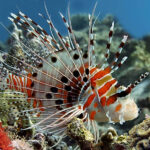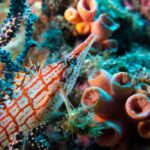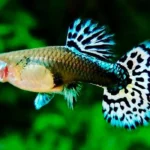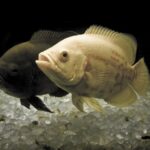Silent Hunters of the Reef
Hawkfish Not all beauty is passive in the radiant world of coral reefs, where colors explode and life abounds in every crevice. The fish stands out among the frenzied inhabitants of the reef for its behavior rather than its flashiness.
Prepare to meet one of the most intriguing and underrated inhabitants of the reef.
The reef is watched by these ambush predators. With sharp, unblinking eyes, they perch on coral branches like hawks and observe the vibrant world around them.
They are, however, much more than meets the eye. These unassuming fish are an essential component of the reef ecosystem because they maintain equilibrium in the population dynamics of their prey and exhibit fascinating evolutionary adaptations. In this article, we go into great detail about the world of fish, talking about everything from their biology and natural habitat to their role in coral reef ecosystems and how they do in aquariums at home.

What Is a Hawkfish?
There are approximately 30 species of fish in the Cirrhitidae family, which includes 12 genera. They belong to the largest vertebrate order, the Perciformes, which also includes numerous popular reef fishes.
The fish’s modified pectoral fins, which act as arms to hold themselves in place on coral heads or rocks, are perhaps their most distinctive feature. They are always ready for the next attack because of this trait, which enables them to remain still in turbulent water without expelling a lot of energy.
Habitat and Distribution
The Red Sea, Indian Ocean, and the warm tropical waters of the western and central Pacific are all home to hawk in the Indo-Pacific region. In addition, there are a few species in the Atlantic and Caribbean.
Where to Look for Them:
Slopes and crests of coral reefs, reef flats, and rocky apex areas with strong currents (where other fish may find it difficult to stay afloat).
They like shallow reef environments with lots of places to perch and good visibility. While some species prefer Acropora, a type of branching coral, others are content to rest on rocks or sponge-covered substrates. Strangely, hawkfish rarely interact with other fish. They will not swarm like damselfish or school like anthias. During the breeding season, each individual fiercely defends their territory.
Behavior and Hunting Strategy
Not only do hawk resemble birds of prey in their hunting style, but their behavior also gives them their name. They wait, like hawks. They look around. They then strike with startling speed.
Their Method of Predation:
Perch and Wait: Hawkfish look for movement from a high vantage point, typically a coral head or rock.
Ambush: They lunge with lightning-fast accuracy whenever a small fish or invertebrate gets too close.
They quickly return to their perch after a strike, occasionally shaking the prey in their jaws. This ambush tactic saves a lot of energy and works very well, especially in the competitive and diverse coral reef ecosystem.

Diet in the Wild
Hawkfish consume meat. The majority of their natural diet is composed of:
Tiny fish
Shrimp Crustaceans, such as copepods
Amphipods are invertebrates that live on the reef
Cleaner shrimp and other small reef invertebrates can be affected by their predation habits, making them both predators and ecological influencer in their habitat.
Species Spotlight
Oxycirrhites typus Longnose Hawkfish
Color: Red pattern that looks like a grid on a white
body. 5 inches in length.
Habitat: Gorgonian fans and black coral branches are preferred habitats.
Known for their unusually long snouts, which they use to retrieve prey from crevices, their behavior is quiet but clever.
(Cirrhitichthys oxycephalus) Pixy Hawkfish
Color: pink to white, with red spots or blotches.
Reproduction and Life Cycle
Hawkfish exhibit some fascinating reproductive strategies, particularly protogynous hermaphroditism, meaning they start life as females and can change to males if needed.
Behavior of Spawning:
usually takes place at dusk.
Pairs ascend into the water column and simultaneously shed eggs and sperm.
Eggs that have been fertilized are pelagic and move with the currents. If the dominant male is taken away or dies, the largest female in a group will become the male in a territorial species.

Hawkfish in Home Aquariums
Due to their hardy nature, unique behaviors, and vivid colors, hawkfish are popular choices for saltwater aquarium enthusiasts.
Why They’re Great for Aquariums:
Very adaptable to tank life. Don’t require a constant swimming space. Generally disease-resistant. Aquarium Considerations:
Tank Size: Minimum of 30 gallons for smaller species like Flame or pixy hawkfish. Tank Mates: Avoid very small fish or ornamental shrimp—they may become prey.
Decor: Lots of rockwork and coral perches. Secure frags—they like to perch on everything.
Always monitor behavior, especially during introduction phases.
Role in the Coral Reef Ecosystem
Contributions They Made:
Predation Control: Contribute to the management of small fish and invertebrate populations.
Health of Corals: They indirectly benefit corals by reducing the overabundance of cleaner shrimp or parasitic crustaceans.
Territorial Enforcement: Certain invasive or disruptive species are controlled by their aggressive behavior.
Researchers have observed shifts in the community dynamics of reef fish in areas where hawkfish populations are declining, demonstrating how intertwined they are with reef life.

Conclusion
Hawkfish are more than just vivacious coral reef additions; they are also patient predators, ecological regulators, and enticing behavioral fish. Hawkfish captivate with their stillness, sudden ferocity, and silent mastery of their domain, whether observed perched on a coral branch in a South Pacific lagoon or resting in a home aquarium.
The fact that not all predators chase is made clear by their story. Some look on. Some wait. With each calculated strike, they also shape the ecosystems around them. So, the next time you look into a reef or saltwater tank, look closer the next time you see a small, spiny fish looking around calmly. You might just be watching a hawkfish, a quiet king of its territory, a coral guardian, and a perching predator.
FAQs
Will hawkfish eat shrimp or snails in my aquarium?
Yes, most likely, particularly tiny shrimp like cleaner, peppermint, or sexy shrimp. Although larger shrimp, like cleaner shrimp, when fully grown, may survive, there is always a risk. Since hawkfish rarely target snails, they are usually safe.
What do hawkfish eat in captivity?
Hawkfish eat mysis shrimp, brine shrimp, chopped squid, krill, and high-protein pellets or frozen foods, among other carnivorous foods, in aquariums. They generally enjoy eating and have a preference for meaty foods.
Are hawkfish good for beginner saltwater aquarists?
Yes, many hawkfish species (like the flame hawkfish and longnose hawkfish) are hardy, disease-resistant, and adaptable, making them good choices for beginners with at least some marine aquarium experience.
How big do hawkfish get?
The majority of hawkfish stay relatively small. The length of common species ranges from 3 to 5 inches. The largest hawkfish species may grow up to 8 inches, but those are less commonly kept in aquariums.
Can I keep multiple hawkfish together?
It is not recommended to keep multiple hawkfish in the same tank unless the tank is very big (more than 100 gallons) and has a lot of room for them to roam. They fight, especially if they are of the same species, and they are territorial.










